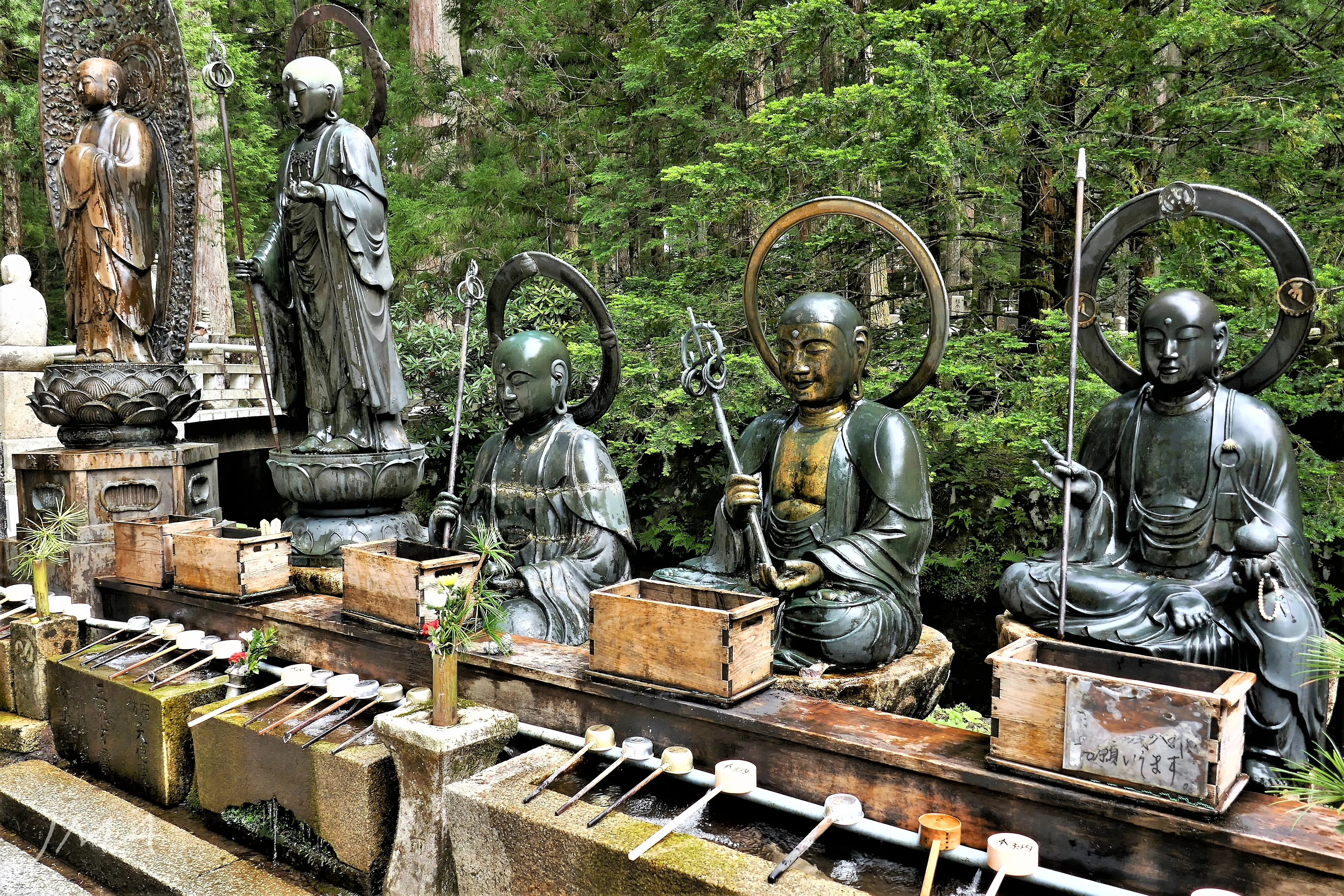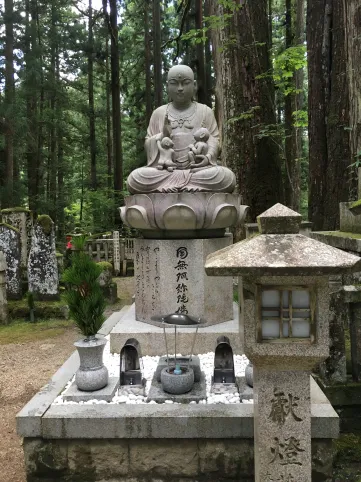The Legend of Kūkai - Father of Japan
- Shannon
- May 7
- 4 min read
Updated: Jul 25
In the year 774, in the small town of Zentsūji on the island of Shikoku, Japan, a child named Kūkai was born. This child would grow up to become one of the most influential and revered figures in Japanese religious history. Known posthumously as Kōbō-Daishi, Kūkai would not only found the Shingon school of esoteric Buddhism but would also leave a profound legacy that shaped both religious practices and Japanese culture for centuries to come.

Born to a wealthy aristocratic family, he displayed remarkable genius at an early age and was sent to the capital to study under his uncle who served as a tutor to the Crown Prince. As a 17 year old prodigy, he entered university in Nara to study classic Chinese literature and Confucian texts, before feeling a deep calling toward Buddhism. Disillusioned with the rigid and uninspiring teachings of the imperial university, Kūkai abandoned his studies pursue a more meaningful spiritual path. Around the age of 20, he renounced worldly life, shaved his head and began living as an ascetic devoted to Buddhist practice. Unlike most monks of the time who were state sanctioned and received government support, Kūkai deliberately chose to distance himself from the institutionalised form of Buddhism dominant in Japan at the time.
In 804 at the age of 30, Kūkai took part in a diplomatic expedition to the capital of Tang dynasty in China, in order to deepen his knowledge of esoteric Buddhism, a form of practice that emphasises rituals, mantras and the belief in the possibility of attaining enlightenment in this lifetime. While crossing the Sea of Japan, Kūkai’s ship was caught in a storm and separated from the rest of the fleet, eventually drifting ashore far south of the intended destination. Their unexpected arrival aroused suspicion from the local governor, who contacted the imperial court for guidance. It was only after Kūkai wrote an elegant appeal in formal Chinese that the delegation was permitted to carry on.

Upon arriving in China, Kūkai journeyed inland to the grand city of Ch’ang-an, then the world's largest and most diverse metropolis and the epicentre of Esoteric Buddhism. There, the teachings had taken deep root, largely under the guidance of the highly esteemed monk named Hui-kuo. Yet Kūkai had to endure a wait of over five months before he could meet the Buddhist master, who by then was seriously ill and nearing the end of his life. Despite this, their meeting was extraordinary. Hui-kuo, sensing something profound, immediately recognised Kūkai as the rightful successor to the esoteric teachings, exclaiming with joy, "Until now, there was no one to whom I could pass along the secret teachings. I have been waiting for you". During his time in China, Kūkai was formally ordained and rapidly initiated into the core teachings of Esoteric Buddhism, including the profound secrets of the two mandala realms. As Hui-kuo’s health declined, there was a clear urgency in passing on the tradition, with monks rushing to prepare sacred texts, ritual tools and Buddhist images for Kūkai to take back to Japan. In addition to his spiritual training, Kūkai studied Sanskrit, calligraphy and poetry under leading scholars, quickly mastering his lessons. By the time Kūkai departed China in 806, he had not only become the eighth patriarch of Esoteric Buddhism but was also recognized as the spiritual heir of Dainichi Nyorai. To honour his new status, Hui-kuo gave him the name Henjō-kongō, meaning “The Diamond that Illuminates the Four Directions.”

In 816, Emperor Saga approved Kūkai’s petition to create a secluded monastic center deep in the mountains of what would become Mount Kōya. Kūkai envisioned this sacred site as a living embodiment of Shingon Buddhism’s core cosmology. The mountain’s geography lent itself perfectly to this vision. The central plateau symbolised the Womb Realm mandala, encircled by mountain peaks shaped like the petals of a lotus blossom. At its heart, Kūkai planned the construction of Kongōbu-ji, the “Diamond Peak Temple,” representing the Diamond Realm mandala. Though the land was ritually consecrated in 819, the full realisation of Kūkai’s spiritual blueprint would not be completed until after his death.
By late 832, Kūkai had returned to the serene heights of Mount Kōya, where he spent the final years of his life in deep meditation and spiritual practice. On March 21, 835, at the age of 62, he is said to have entered a state of eternal meditation rather than experiencing death in the conventional sense. Honouring his final wishes, he was not cremated but enshrined in a stone mausoleum on Mount Kōya’s eastern peak. According to legend, when the tomb was later opened, his body appeared untouched by time, his face serene, his hair still growing, as if peacefully asleep. Moved by the loss and his legacy, the Emperor bestowed upon him the posthumous title Kōbō Daishi, meaning “The Great Teacher Who Spread the Dharma.”

Kōbō Daishi’s legacy endures as one of Japan’s most spiritually influential figures, with hundreds of temples across the country honouring his life and the Shingon tradition he established. Central to Shingon Buddhism is the belief that enlightenment can be attained within a single lifetime by awakening to the truth that the divine source of all existence resides both in the universe and within the human body. Even today, monks at Mount Kōya offer meals to Kōbō Daishi twice daily, believing he remains in a state of eternal samadhi, deep meditative absorption within his mausoleum. They hold that he is not dead but patiently awaiting the arrival of Maitreya, the future Buddha. True to his vow, Kōbō Daishi is said to continue his prayers for the liberation of all beings, unwavering in his compassion until the end of time.
Location : Koyasan, Kōya, Ito District, Wakayama Prefecture 648-0211, Japan
How to get there : The main cemetery entrance, via Ichinohashi bridge, is about 15 minutes walk from the town centre (tourist office) or a short bus ride (during daytime only). From here it is a 2km walk to Kobo Daishi’s mausoleum. I suggest you return via the Okunoin-mae exit from which it is around a 20 minutes walk or a short bus ride to the town centre.
Attraction Info : Okunoin Cemetery is open at all hours though the Torodo and temple buildings are generally only open from 6.30am to 5.30pm. Entry is free.
Thanks for reading about The Legend of Kūkai - Father of Japan. Check out some more destinations here!




















